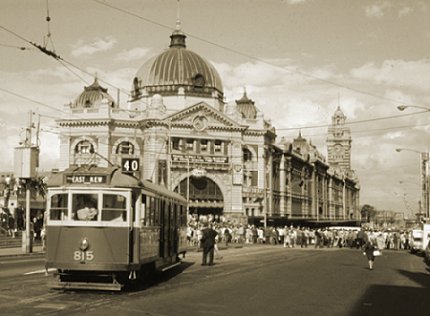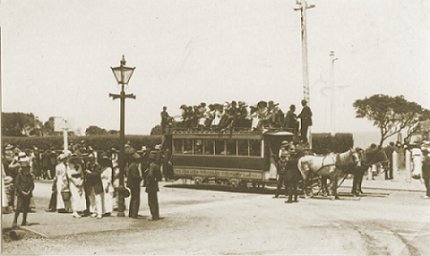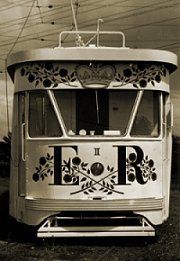Melbourne Tram Museum
- Follow Melbourne Tram Museum on Twitter
- Follow Melbourne Tram Museum on Facebook
- Follow Melbourne Tram Museum on Instagram
- Follow Melbourne Tram Museum on Pinterest
- Follow Melbourne Tram Museum on Tumblr
- Subscribe to Melbourne Tram Museum's RSS feed
- Email Melbourne Tram Museum
Haunting the rails: ghost trams of Melbourne
In Melbourne, the term ‘ghost tram’ is occasionally used to describe trams with mysterious route numbers and strange destinations that never appear on public timetables. The majority of passengers are reluctant to board a ghost tram, for fear that they will be left at some unknown location, waiting in vain for a ‘proper’ tram to take them back to the safe and familiar.
Long-term Melbourne residents and tram enthusiasts do not have this concern, leaping on board ghost trams in the sure knowledge that an 18 will get you to Queen Victoria Market just as well as a 19, or that a 76 will safely take you to Camberwell Junction without having to wait for the next 70 or 75. They also know the locations of all the tram depots, so are unafraid to hop on a tram going back to the depot. In fact, some prefer to take uncrowded depot-bound trams, knowing that the tram driver will be eager to finish her shift and will do her best to give them a quick trip.
During the period where the tram system was operated by the Melbourne & Metropolitan Tramways Board (M&MTB), ghost trams hardly existed. Timetables were wonderfully detailed and annotated, showing every service. Short workings – the trammies’ name for ghost trams – were assigned route numbers close to that of the normal full-length service. For example, route 71 was a short working of route 70, terminating at Warrigal Road rather than going all the way to Wattle Park.
 Route
40 was a short working of route 48 to North Balwyn. W5 815 is short
shunting for its outward journey at a crossover in Flinders Street
on 9 March 1970, as Swanston Street is closed for the annual Moomba
parade, preventing 815 from shunting at the normal terminus in Spencer
Street.
Route
40 was a short working of route 48 to North Balwyn. W5 815 is short
shunting for its outward journey at a crossover in Flinders Street
on 9 March 1970, as Swanston Street is closed for the annual Moomba
parade, preventing 815 from shunting at the normal terminus in Spencer
Street. - Photograph courtesy Warren Doubleday.
There were some ghost trams during the tenure of the M&MTB. In 1954, to celebrate the Royal Visit to Australia of Queen Elizabeth II the M&MTB decorated and illuminated PCC prototype tram 980. Appropriately painted white with royal insignia, the ghost tram – known as the ‘silent’ car for its smooth and quiet operation – was operated over the entire network, without carrying any passengers in its temporary role.
After privatisation of the tramway system in 1999, infrastructure savings were obtained by removal of many intermediate crossovers. Additionally, increasing population on the outer sections of most tramlines resulted in rising patronage and changes in traffic patterns. These two factors have caused the reduction or outright elimination of many short workings, particularly on the outer sections of longer routes. Consequently, many route numbers assigned to short workings have fallen out of use, or have been reassigned for other routes.
Additionally, in order to prevent ‘confusion’ to the travelling public and provide ‘better’ customer service, the new operators stopped publishing timetables with the remaining short workings – most of which were depot workings. This was partly driven by the conditions of the franchise agreements with the State Government, and set the scene for the public perception of ghost trams.
The end result has been that the underlying logic behind the original allocation of route numbers has evaporated, leaving the public – unaware of the history behind route number allocation – with the impression that numbers have been assigned more or less at random. In 2008 ghost tram services accounted for 10% of total tram kilometres.
The first known use of the term ‘ghost tram’ dates back to 1914, just prior to the closure of the Beaumaris Tramway Company’s horse tram service between Sandringham and Beaumaris via Black Rock. The Company – which had never paid a dividend since opening in 1889 – desperately hoped to stave off total financial ruin. Victorian Railways proposed to open an electric tramway between the same termini, so the Company wanted to remain open long enough to force a compensation payment. However, in order to claim any such compensation it had to be shown to be a going concern, and the terms of the contract with the Moorabbin Shire Council obliged the Company to run at minimum a daily service.
By this stage the rolling stock and line were in a parlous condition, most of the horses had either died or been sold, and those few remaining more fit for the knackery than hauling a tramcar. Operation of the tramway in such a state almost guaranteed a serious accident, leaving the Company liable for consequent claims which it could not afford. Therefore in order to meet its contractual obligations, the Company operated a single ghost tram service at midnight, to avoid taking any passengers.
Even this limited service proved too expensive, until the Company realised there was a clause in its contract that, following an accident, required it to restore service within a fortnight. It was not a stretch to declare an accident with each operation of the tram, so the ghost tram service frequency dropped to every second Sunday. Only a few more ghost trams were run before the Beaumaris Tramway Company finally collapsed into bankruptcy in the middle of 1914.
 Beaumaris
horse tram, c1900-1910.
Beaumaris
horse tram, c1900-1910. - Photograph from the Melbourne Tram Museum collection.
The Act for the new electric tramway between Sandringham and Black Rock was passed in November 1914. The route was chosen specifically to bypass the former tracks of the Beaumaris Tramway Company to avoid claims from its creditors.
Today, the operation of ghost trams on the Melbourne system is hardly so dramatic. In fact, Yarra Trams is attempting to eliminate them.
To meet this challenge, in 2012 Yarra Trams re-introduced route letters to Melbourne trams, suffixing two-digit route numbers with either ‘a’ or ‘d’.
- The ‘a’ suffix is used to denote a short working, often as a result of service disruptions such as track or overhead maintenance. There is no permanent assignment of the suffix to any particular short working on a route, as passengers are expected to familiarise themselves through reading information on disrupted services issued via traffic notices or the Yarra Trams website. The only exception to this rule is on the weekends-only route 3a, which is an alternate routing of route 3 to East Malvern via St Kilda, instead of the normal weekday routing via Brighton Road.
- The ‘d’ suffix denotes a short working direct to a tram depot, rather than to the normal terminus. For example, a 75d is a short working of the South Vermont route 75 tram, terminating at Camberwell Depot.
While this rule is logical enough, there remains a problem due to the three character limitation on most programmable destination displays when combined with the small number of three digit route numbers. It also does not address short workings on the few remaining W class services – routes 31, 35, 78 and 79 – and the traditional two digit route number boxes. The abandonment of individual route numbers for short workings means there are large gaps in the list of route numbers published on timetables and the Yarra Trams website.
Perhaps ghost trams will be haunting the rails for some time yet.
Bibliography
Jones, R. (2003), Hooves
and iron: Melbourne’s horse trams, Melbourne Tram Museum
Jones, R. (2003), VR Electric
Street Railways, Melbourne Tram Museum
Macdonald, E. (1934), When
the Ghost Tram Ran at Black Rock, The Argus, 15 September 1934
Sexton, R. (2008), On
Our Tramway’s Secret Service, The Age, 14 September 2008
The Advertiser (1954), Melbourne’s
‘Ghost’, 14 January 1954
